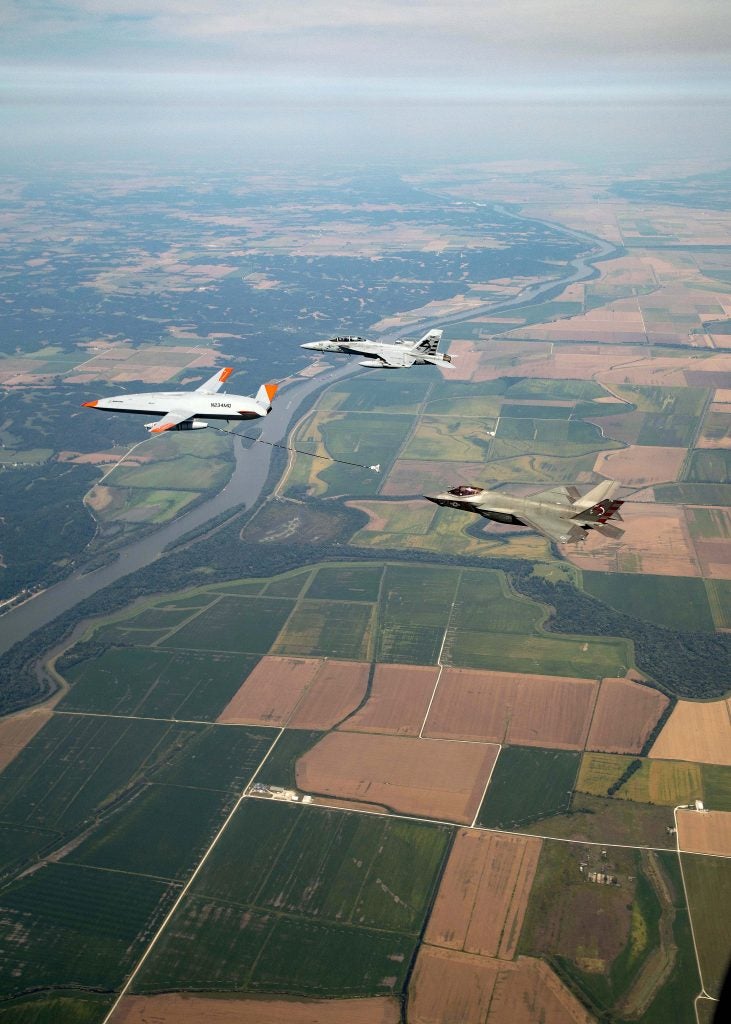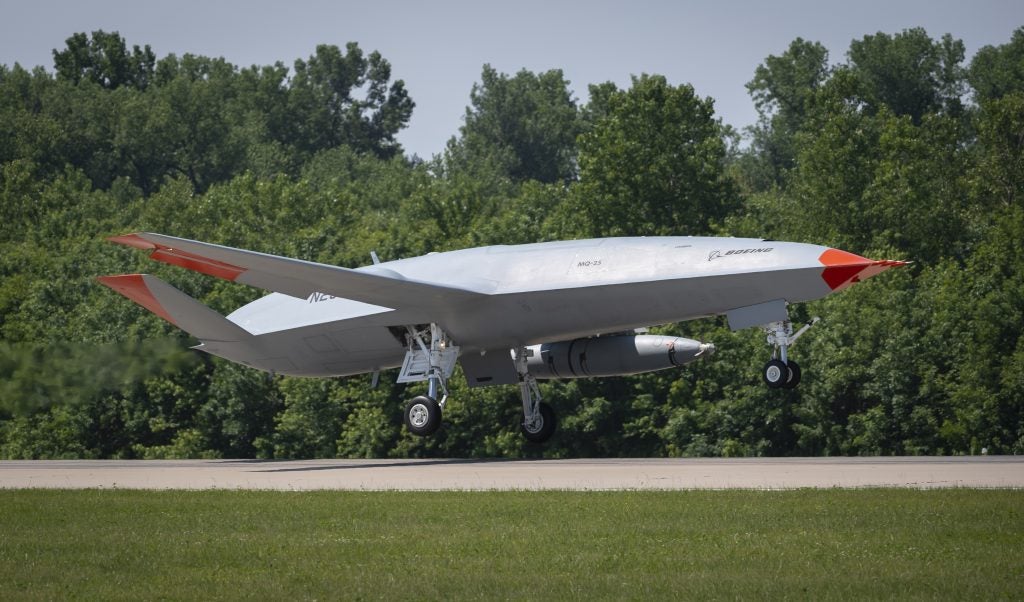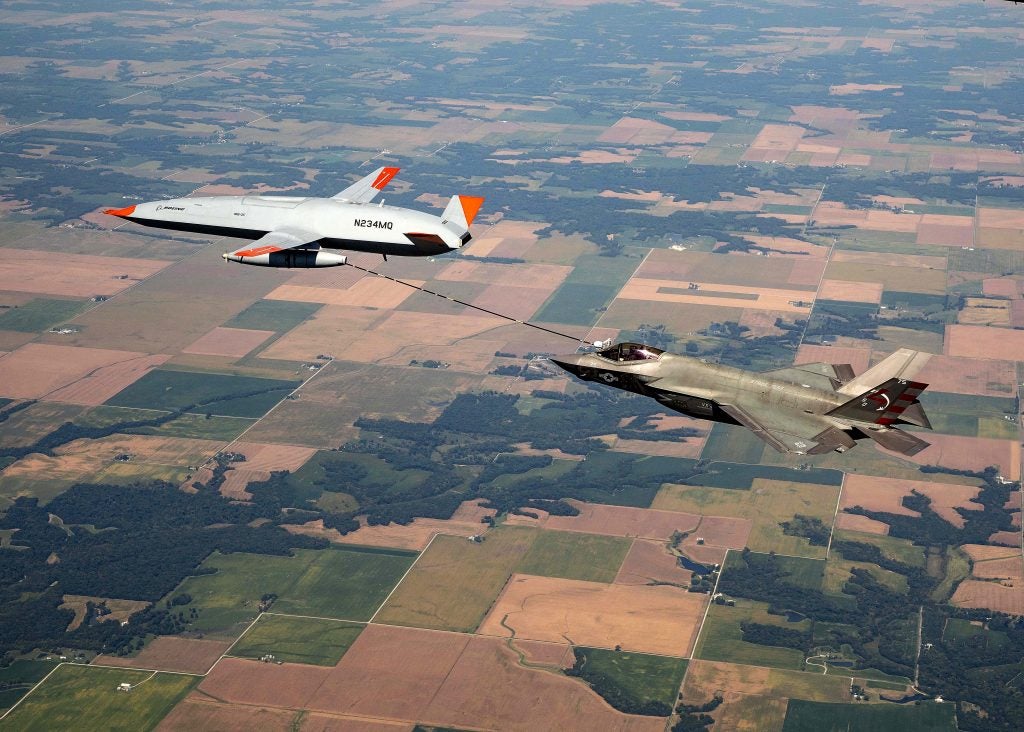How the MQ-25 Solves the Navy’s Decade Long Issue with New Technology
On September 13, T1, one of the Boeing-owned MQ-25 test aircraft conducted a historic aerial refueling with an F-35C from the Navy’s Air Test Wing and Evaluation Squadron Two Three (VX-23). The event occurred near MidAmerica St. Louis Airport in Mascoutah, Illinois.
For T1 test aircraft, this event was the aircraft’s third aerial refueling with a manned aircraft, following several prior tests with F/A-18 Super Hornet and E-2D Hawkeye aircraft. This event marked the 37th flight for the aircraft since the test flights began, the aircraft has been collecting valuable data as part of testing the airframe’s aerodynamics, subsystems, and performance.

According to the press release by NAVAIR, T1 aircraft will begin a modification period to prepare for the integration of the deck handling system to conduct a shipboard demonstration this winter. The upcoming shipboard demonstrations would mark the second time unmanned aerial vehicles have integrated into the carrier deck, following similar tests in the past done by the X-47B. When operational, the MQ-25 will be capable of refueling all receiver capable aircraft of the carrier air wing.
The Regressive Origins of the MQ-25

The MQ-25 platform is the winner of the Carrier-Based Aerial-Refueling System (CBARS) program, a program that watered down and replaced the Unmanned Carrier-Launched Airborne Surveillance and Strike (UCLASS) program, which has its roots in several UCAV programs initiated by the Department of Defense. One of these programs was the joint DARPA-Air Force project named Unmanned Combat Air Vehicle (UCAV) which began in 1999, this program was followed by a joint DARPA-Department of Navy program dubbed Unmanned Combat Air Vehicle-Navy (UCAV-N) which began in the year 2000.
During the early stages of the UCAV-N program, the DARPA-Navy team awarded $2 million each to Boeing and Northrop Grumman for trade studies, analyses, and the preliminary design phase of the program. Both companies in the UCAV-N program each had one air vehicle available, the Boeing-made X-45 which won the Air Force UCAV program, which as such wasn’t suited for naval use, and the Northrop Grumman Corporation’s self-funded X-47A. According to AIAA, early-stage concepts included ‘‘a Vertical Takeoff & Landing (VTOL) “fan in wing” design, tailed configurations optimized for long-endurance ISR, and tailless, low aspect ratio flying wings for SEAD/strike missions’’. As time went by, the trade space of concepts was further refined, the Navy desired a design with long-range, high payload capacity, high endurance, and the ability to fly in non-permissive airspace. These UCAV-N concepts would lead to the modifications of the X-47A’s design. While the original “Kite” design of X-47A was optimized for SEAD (suppression of enemy air defense) style missions, the suitability of the design for a long-range strike and high payload capacity was limited. The X-47A design had very low-aspect-ratio wings, which would hamper the aircraft’s range and due to the craft’s center of gravity (CG) placement, its design necessitated munition and fuel stores to be moved forward, where the craft had less volume for both. To remedy these issues, an improved design was developed in early 2001, the new design would increase the craft’s wing aspect ratio, which in turn mitigated the CG issues, the “cranked kite” design which would later be improved and designated X-47B, got the X-47A much closer to meeting the Navy’s concepts. The cranked kite design began wind tunnel testing in 2001.
On the other hand, the Boeing X-46 design, which would be purposely designed for the UCAV-N program due to X-45A not being carrier suitable, didn’t include such drastic long-range optimization changes as the X-47B did. The aircraft resembled that of an enlarged X-47A, with more aggressively swept-back wings, the X-46 had kept to a low aspect ratio wing design and would later serve as the basis for the Air Force X-45C.
In 2003, both Air Force and Navy programs with DARPA were merged as the Joint Unmanned Combat Air Systems (J-UCAS) Program. Following the merger of the programs, it would undergo several restructures before it settled on Navy leadership. The 2006 Quadrennial Defense Review Report (QDR) called for the Navy to develop “an unmanned longer-range carrier-based aircraft capable of being air-refueled to provide greater standoff capability, to expand payload and launch options, and to increase naval reach and persistence.” The Navy would award a contract for the UCAS-D to Northrop Grumman for their X-47B, following several successful carrier landings, the path for an acquisition program was laid in the form of the UCLASS program.
Following the Navy’s retirement of both the Grumman KA-6 and later Lockheed S-3 Viking in 2009, the requirement for a viable aerial refuelling platform has become pressing. Due to disagreements between the U.S. Navy and Congress on the roles of the UCAS aircraft, the UCLASS program would end up being replaced by a very low-risk program with throttled-down requirements. This program would be called the Carrier-Based Aerial-Refueling System (CBARS) program. The program would focus on giving the Carrier Air Wing an extended reach, in an interview with USNI Proceedings, Vice Adm. Mike Shoemaker said the goal was for “the unmanned aerial vehicle to be able to deliver about 15,000 pounds of fuel at 500 nautical miles.” The Navy picked Boeing’s MQ-25 platform as the winner of the program in August 2018. It’s first test flight was completed in September 2019.
As the MQ-25 gets closer to an operational system, it will fill the large capability gap left by retiring the KA-6 and S-3 Viking. Currently, 20 to 30 percent of the F/A-18s on deck are dedicated to refueling missions, the MQ-25 would not only free up more strike aircraft but would also extend the reach of the current air wing even further.

